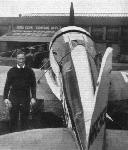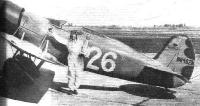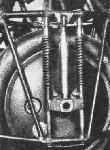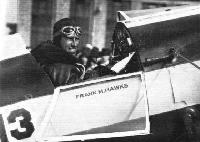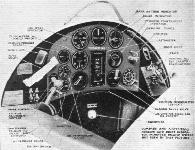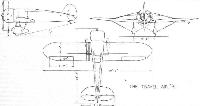
Flight, April 1931
THE TRAVEL AIR MODEL "R
An American Commercial Aircraft with a Phenomenal Performance and the holder of Many Spectacular Records
THE Travel Air "Mystery Ship" with its phenomenal performance has been the subject of much conjecture and wild report since it has performed many astonishing flights in the hands of Capt. Frank Hawks, Lt. James H. Dolittle and Mrs. Florence L. Barnes. It first made its appearance at the National Air Races of America in 1929 at Cleveland, piloted by Douglas Davis, and created a sensation by doing one lap of the closed course at 228 m.p.h. A large number of record flights have since been made with this aircraft, notably those of the coast to coast record by Capt. Hawks which was made from the Glendale Air Port, Los Angeles, to Valley Stream, New York, on August 13, 1930, in 12 hr. 25 min. 3 sec, of which only 11 hr. 40 min. were flying time. Capt. Hawks also flew from Detroit to New York on September 30, in 2 hr. 41 min., and on October 7 he flew from Boston to New York in 54 min. 15 in 54 min. 15 sec. and from Philadelphia to New York on October 9 in 20 min.
The Travel Air low wing model R., which is the correct name of this machine, makes use of the Wright 9 cylinder 450 h.p. engine, which, by the use of 6:1 compression ratio, high revolutions and a very low weight, gives this machine a low power loading. The engine is enclosed in a form of the widely advertised N.A.C.A. cowling, now called the Venturi cowl, which certainly decreases the drag to an enormous extent. In this case, preceding as it does the circular sectioned fuselage, the exit from the cowl would appear to have a very definite slot-like effect, and probably maintains a smooth flow for a long way back down the fuselage. Incidentally, the scale drawings, for which we have to thank our American contemporary The Scientific American, show that this fuselage is definitely swept inwards in the region of the pilot's cockpit, and this may possibly have some additional effect in reducing the drag much on the lines advocated by M. Poncelet in his little Monoplane. The engine mounting is of steel tubular construction, and is detachable, while the main fuel tank, of 86 gallon capacity, is constructed of aluminium, and is carried on the bottom longerons in the fuselage bay, directly behind the engine. A five gallon reserve tank is carried behind the main tank, and connected to it by means of a wobble pump. The engine feed is said to be by gravity through 1/2 in. pipe lines, but, judging from the drawings, the head achieved by this can hardly be up to British requirements.
The engine cowling, made of about 20 gauge aluminium, also has baffles between the cylinders, and the inner cowling, which extends back to the cockpit, is made of the same material.
The oil coolers are mounted on the stub wings, and the cooling fins are under the cat-walks.
Between the engine mounting and the tank there is, of course, the usual aluminium and asbestos fireproof bulkhead. The propeller used is an 8 ft. diameter standard steel one, set at a pitch of 22°.
The landing gear is reminiscent of the De Havilland Tiger Moth, except that the springing from each wheel is carried externally on a framework built round it, and is a combination of two oleo cylinders and four coil springs for each wheel. The wheels with this springing are braced to the outer ends of the wing stubs by N struts, and these struts are further braced by three streamline wires, which run outwardly to the wing spars with two others to the opposite wing stubs; finally, each wheel is encased in a streamline cover of about 20 gauge aluminium. Bendix wheel brakes are fitted.
A very short tail skid with a streamline shoe is sprung by means of a coil spring and oil dash-pot, and gives a ground angle of 13°. The wing itself is tapered in plan form and thickness, and is of R.A.F. 34 section, with the centre of gravity set at 24 per cent, of the chord. The wing bracing is by means of the already mentioned flying wires to the N chassis struts, and by similar streamline landing wires to the top of the fuselage. The wing is constructed of spruce and 1/16 in. mahogany plywood, with which it is completely covered, and the spars are built up of spruce beams not spindled in any way. All metal fittings in the wing are of chrome molybdenum steel, and the compression ribs are boxed spruce ribs with plywood webs. The ordinary former ribs are of spruce with plywood gussets. The drag bracing is by means of tie rods, and these together with the plywood covering make the wing extremely rigid.
The ailerons are fabric covered and. constructed of chrome molybdenum steel, are attached to a false spar by three hinges, and the elevator, fin, rudder and tailplane are made with built-up steel tubular spars, stamped steel ribs, and are fabric covered. The fuselage is of welded steel tube and wedge shaped, faired out to a well rounded cross section and covered with 1/16 in. mahogany three-ply wood, and the whole structure is tubular braced.
The ailerons are operated by a torque tube and a differential push and pull tube system, while cable control is used for rudder and elevators. The tailplane is adjustable in the air and the fin is adjustable on the ground.
Capt. Hawks, who is the aviation adviser in charge of the aeronautical activities of the Texas Oil Co., Ltd., whose registered office is at 125/130, Strand, W.C.2, is visiting Europe for the purpose of studying European flying conditions and conferring with the officials of the Texas Oil Co. in Europe regarding aeronautical matters. It is expected that he will remain over here two or three months. It is not his intention to make or break any speed records during his European visit, although he will undoubtedly make many rapid flights between various European air ports.
On Saturday, April 18, he landed at Croydon at about 3.20 p.m. after having left Brussels at four minutes past two. Afterwards he went on to Hanworth Park, where he was met by Col. Shelmerdine, the Director of Civil Aviation; Mrs. Shelmerdine; and Capt. the Hon. F. E. Guest; subsequently he flew to Heston, where he made a beautiful landing and thoroughly demonstrated the efficiency of his wheel brakes.
On inspection at Heston, the machine offered many interesting points. In looking into the cockpit, one of the first things one noticed was the slide rule on the port side of the dashboard. Whether any pilot flying across country at over 200 miles per hour would have time to use this would seem very doubtful, and presumably it is for this reason that this instrument is sealed with a lead seal. The sliding curved top of his wind screen was particularly interesting, and this apparently can be pushed forward where it acts as a normal, although very small, wind screen, or when it is desired to utilise the machine's speed to the full it can be pulled completely over the pilot's head. Each side of the cockpit is composed of a folding panel of fairly thick Cellon, through which the pilot gets a reasonable view of the surrounding country. This view is assisted by the inward sweep of the fuselage, of which we spoke at the beginning of this article.
At the tail end of the fuselage very neat telescopic handles are fitted for man-handling the machine on the ground, and these can be pushed right home so as to offer no drag at all when not in use.
The streamlining of all projections has been carried out very carefully, and all wiring lugs are completely encased in streamline fairings of papier-mache or some other suitable substance. Similarly, the elevator, aileron and rudder hinges all have streamline caps over them. Under the same heading comes the complete very fine finish of the machine, and the result obtained with the lacquered fabric covering on the tail-surfaces should be of great interest to our manufacturers over here.
The landing wires are stabilised by a short vertical length of streamline wire above the front spar and a connecting rod to the rear wire.
The attachment of the engine cowling is interesting, and is effected by means of straps which hook over a detachable hinge at the front, and are secured at the rear by a tension bolt.
The engine exhaust system is particularly interesting, as the stub exhausts are not extended outside the outer cowing ring and play direct on to asbestos sheets attached to the inside of the cowling. It would appear, therefore, that the exhaust blast must very materially assist the cooling draught between this and the inner cowling and so around the cylinders. No doubt the blanketing effect of this outer cowling ring round the exhaust outlets accounts to a very large degree for the exceptional silence of the machine.
Navigation lights are another point where evidence is shown of great attention to detail, since they are of very small streamline shape and both on the wing tips and rudder are of the Duplex kind, that is, they show their appropriate lights on each side of the particular surface to which they are attached.
Capt. Hawks appears to be of that type of mentality which trusts its luck to fetishes which others consider unlucky, since the registration letters and number of the machine is NK. 1313, while the Company's number in the shape of Texaco 13 is painted on the machine very prominently. A small map on the fuselage shows his route on his trans-Continental record flight.
- Flight, April 1931
THE TRAVEL AIR MODEL "R
Фотографии
-
Aeroplane Monthly 1978-05 / Travel Air Model R /Preservation Profile/ (61)
Регистрационный номер: NR1313 [16] -
Aeroplane Monthly 1979-11 / I.Best-Devereux - Oshkosh'79
Регистрационный номер: R614K [3] Jim Younkin’s reproduction of the Travel Air Mystery S racer, winner of the 1929 Thompson Trophy, took nearly three years to complete and cost $15,000. A 300 h.p. Lycoming replaces the Wright of the original. It first flew in March 1979.
-
Aeroplane Monthly 1996-11 / M.Roffe, D.Baker - Great moments in aviation (18)
Регистрационный номер: R614K [3] Travel Air Model R R614K - christened the “Mystery Ship” by the Press owing to the secrecy surrounding its preparation for America’s 1929 National Air Races at Cleveland.
-
Aeroplane Monthly 1978-05 / Travel Air Model R /Preservation Profile/ (61)
Регистрационный номер: NR1313 [16] Airborne after the transcontinental record flights, 1930
-
Flight 1932-01 / Flight
AN AMERICAN SPEEDSTER: A fine flying view of the Travel Air model R which shows the cleanliness of the under-carriage with its wire bracing..
-
Flight 1931-05 / Flight
Регистрационный номер: NR1313 [16] This side view of Capt. Hawks in the Travel Air "Texaco 13" shows how, by means of his adjustable seat, he is able to raise himself and, having pushed the top part of the windscreen forward, thus obtain a good view when approaching an aerodrome.
-
Flight 1931-04 / Flight
Регистрационный номер: NR1313 [16] U.S. SPEED KING IN EUROPE: Capt. Frank M. Hawkes, the well-known American cross-country pilot, and his "mystery" monoplane, the Texaco 13 Travel Air, are now in Europe, record hunting. On April 6 he flew from Cherbourg to Le Bourget in 54 minutes, at a speed of 228 m.p.h. - a record for the trip.
-
Flight 1931-05 / Flight
Регистрационный номер: NR1313 [16] The Travel Air "Texaco 13" monoplane of Capt. Hawks created much interest at the Orly Meeting. Gen. Bares, Chief of Air Service (left), and Gen. Poli-Marchetti (right) are here seen discussing the machine.
-
Aeroplane Monthly 1978-05 / Travel Air Model R /Preservation Profile/ (61)
Регистрационный номер: NR1313 [16] At Croydon during the European Tour, April 18, 1931
-
Flight 1931-04 / Flight
Регистрационный номер: NR1313 [16] This view emphasises the cleanliness of the undercarriage, though many designers may not agree that wires in such a case produce less drag than a strut would.
-
Aeroplane Monthly 1978-05 / Travel Air Model R /Preservation Profile/ (61)
Регистрационный номер: NR1313 [16] -
Flight 1931-05 / Flight
Регистрационный номер: NR1313 [16] Capt. Hawks at Brooklands. This photograph shows the rapid sweep-in of the fuselage in the region of the pilots cockpit. The very complete windscreen fairing over the cockpit is seen easily from this view
-
Aeroplane Monthly 1978-05 / Travel Air Model R /Preservation Profile/ (61)
Регистрационный номер: NR1313 [16] Nearly new, after repainting in Texaco colours, 1930
-
Aeroplane Monthly 1983-09 / P.Capon - Capon's Corner
Регистрационный номер: NR1313 [16] Capt Frank Hawkes in his Travel Air Model R at Hamble on June 22, 1931.
-
Flight 1936-04 / Flight
Регистрационный номер: NR482N Mr. "Jimmy" Haizlip with one of the successful Travel Air "R" monoplanes of a few years back. One was seen over here in the hands of Capt. Frank Hawks.
-
Flight 1936-10 / Flight
Регистрационный номер: NR1313 [16] RETRACTABLE VISION: The American caption to the picture reads "Smooth as a raindrop from nose to tail, Captain Frank Hawks' new mystery ship, Time Flies, will knock speed records silly when he puts it in flight later this month." The machine has a Pratt and Whitney Twin Wasp engine and retractable cockpit enclosure and undercarriage.
-
Flight 1937-04 / Flight
Регистрационный номер: NR1313 [16] TIME FLIES: Even the hustlers and bustlers of New York paused recently to goggle at Capt. Frank Hawks' new monoplane, with which, sponsored by an American watch company, he hopes to make his "come-back" in the record-breaking game. The engine is a Pratt and Whitney Twin Wasp of over 1,000 h.p. The undercarriage is retractable - and so are both pilot and windscreen: after reaching his altitude Hawks lowers his seat, and the screen automatically closes flush with the fuselage.
-
Flight 1931-04 / Flight
The self-contained oleo-cum-spring shock-absorbing mechanism for each wheel is understood easily from this illustration.
-
Flight 1931-04 / Flight
The Venturi engine cowling, which it can be seen consists of two distinct portions, is made of 20 G. aluminium sheet and plays an important part in decreasing the drag of the fuselage.
-
Flight 1931-04 / Flight
Регистрационный номер: NR1313 [16] Capt. Hawks in his cockpit. The action of the sliding wind screen is plainly visible.
-
Flight 1931-04 / Flight
Регистрационный номер: NR1313 [16] The Texaco No. 13 is used as a flying laboratory and consequently many special instruments have been fitted.
-
Aeroplane Monthly 1996-11 / M.Roffe, D.Baker - Great moments in aviation (18)
Регистрационный номер: R614K [3] The Travel Air “Mystery Ship” over Cleveland: September 2, 1929 by Michael Roffe
-
Flight 1931-04 / Flight
The Travel Air "R"
- Фотографии












